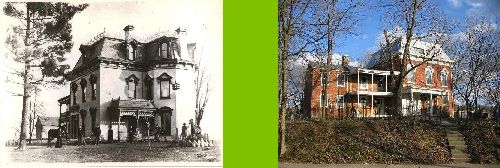I have the daunting task of lining 7 chimneys. None will get done until spring at this point because of the likely chance of it freezing in the next few weeks and the mortar not being fully cured, but I am planning how I am going to do three of them already. Some will be lined with flexible stainless steel liners. Especially those that service fireplaces on the ground floor. I may attempt to line two of them with clay tile liners though because it would be cheaper and I have the room in the flue to lower them down from the roof. Today I removed the one and only damper that existed. It was installed in the large fireplace in the "cottage" side of the house. This fireplace was the original means of cooking back in 1845 when the house was built. The two metal hinges for the crane are still embedded in the wall of the fireplace. I used to think that the 36" long cast iron damper unit was original but now I know it wasn't. When I cleaned up the damper door two weeks ago a large hole appeared as the rust got scraped away, so it wasn't going to be much use. The 6" wide opening it presented was going to be a problem for me when it came to positioning and sealing a clay tile liner and was definitely an obstacle for the stove pipe that would have to go through it if we wanted to use the old stove we bought. In order to remove the damper I had to remove the mortar around the edge as well as the four heavily painted metal supports that held it in place that had been embedded into the side walls of the fireplace. I cannot make out what one of the metal pieces was but the other three consist of two 7" screwdriver shafts and the entire blade of a one and a half inch wide chisel! There was another screwdriver shaft bent in a curve at the back for extra support. I guess that with the widespread use of the Phillips head screw someone had no use for these three flathead screwdrivers any more and hammered them a good 6" into the mortar joints so the damper unit could be held in place.
Well, now I can actually stand up inside the fireplace and when the time comes, position the bottom liner tile and seal it in place with refractory cement. I may even use the screwdrivers to support it in place so that I can dump a slushy mortar down the chimney from above to seal it in place. Though some angle iron might be more practical. Now I can get one of those cap mounted flue dampers and run my stove pipe straight up the chimney about 4 feet so that it goes up to the lining tile. In the meantime I have wedged an old foam cushion in the flue to stop the cold air from wooshing into the house.
What can I do with the chisel shaft though? Hmmmmmm.........

1 comment:
I had no idea you could line chimneys yourself.I'm really interesting in hearing how you will do this...we have a chimney that desperately needs to be lined. I don't think it's currently "legal"...in other words we're not allowed to use our fireplace :(
Post a Comment